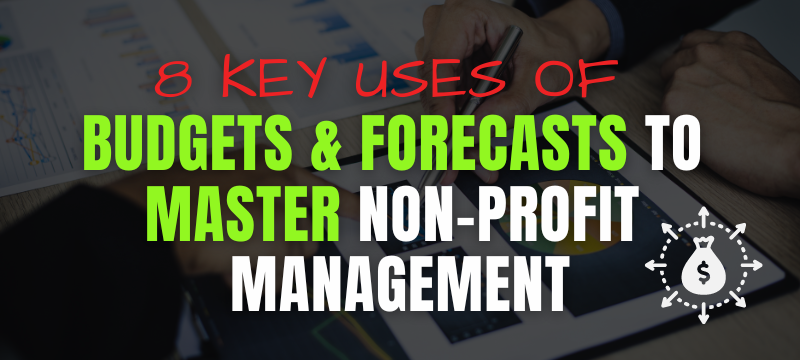In November 2020 OTUS Group hosted a webinar to explore membership retention strategies. Our guests…

8 Key Uses of Budgets & Forecasts to Master Nonprofit Management
As CFOs for nonprofits, we often rely on both budgets and forecasts to guide the financial health and strategic direction of our organizations. While these tools are fundamental to financial planning, they serve distinct purposes and are used differently within the financial management landscape. Understanding the differences between a budget and a forecast can help nonprofits make informed decisions and remain agile in a changing environment.
- Timeframe:
- Budget: A budget typically covers a full fiscal year. It’s created annually and lays out the financial expectations and resource allocations for the entire year, providing a long-term view of financial goals.
- User Case: A nonprofit organization sets its annual budget to plan for fundraising campaigns and allocate resources for upcoming projects.
- Forecast: In contrast, a forecast is updated more frequently, often on a monthly or quarterly basis. It provides a near-term outlook, helping organizations adapt to recent changes and make informed decisions based on the latest financial data.
- User Case: Due to unexpected grant delays, a nonprofit updates its quarterly forecast to adjust spending and ensure cash flow remains stable.
- Flexibility:
- Budget: Budgets are generally static documents, set at the beginning of the fiscal year with only minor adjustments allowed. This fixed nature helps maintain financial discipline and ensures adherence to the planned financial strategy.
- User Case: A nonprofit’s annual budget includes fixed allocations for program expenses, ensuring each initiative receives the necessary funding.
- Forecast: Forecasts are highly flexible and dynamic, regularly updated to reflect changing conditions and new information. This flexibility allows organizations to remain agile and responsive to unexpected challenges or opportunities.
- User Case: After a successful fundraising event, a nonprofit adjusts its forecast to incorporate the additional revenue and plan for expanded program activities.
- Purpose:
- Budget: The primary purpose of a budget is to set financial targets and allocate resources to achieve the organization’s strategic goals. It serves as a financial roadmap, guiding long-term planning and ensuring that funds are directed towards priority areas.
- User Case: A nonprofit uses its budget to set financial targets for new community outreach programs, ensuring resources are allocated to achieve these strategic goals.
- Forecast: Forecasts provide a current view of financial performance, offering insights into how well the organization is tracking against its budget. They help management adapt to new circumstances and make short-term strategic adjustments.
- User Case: A nonprofit monitors its forecast to track monthly donation trends, making adjustments to its marketing strategy to boost donor engagement.
- Detail:
- Budget: Budgets are detailed and comprehensive, encompassing all aspects of the organization’s operations. They include detailed revenue and expense projections, capital expenditures, and other financial commitments.
- User Case: A nonprofit’s budget outlines specific line items for staff salaries, program costs, and administrative expenses, ensuring a detailed financial plan.
- Forecast: Forecasts tend to focus on key financial metrics and trends, often with less detail than budgets. They provide a high-level view of expected financial outcomes based on recent performance and current market conditions.
- User Case: A nonprofit uses its forecast to quickly assess key financial metrics like cash flow and revenue, adjusting for seasonal fluctuations in donations.
- Approval Process:
- Budget: Creating a budget typically involves a formal approval process, requiring the endorsement of the board or governing body. This process ensures that the budget aligns with the organization’s strategic objectives and has the necessary oversight.
- User Case: A nonprofit’s annual budget is reviewed and approved by the board of directors to ensure it aligns with the organization’s strategic plan.
- Forecast: Forecasts, on the other hand, are usually updated by the financial management team without formal approval. This allows for more frequent revisions and quick adjustments to reflect the latest financial realities.
- User Case: The finance team updates the quarterly forecast based on actual donation receipts, allowing for immediate adjustments without board approval.
- Decision-Making Aid:
- Budget: Budgets guide long-term planning and resource allocation, providing a framework for financial decision-making throughout the year. They help ensure that spending aligns with strategic priorities and financial goals.
- User Case: A nonprofit relies on its budget to allocate funds for new initiatives, ensuring alignment with its long-term strategic plan.
- Forecast: Forecasts inform short-term decisions and strategic adjustments, offering a real-time snapshot of financial health. They enable organizations to react promptly to changes and keep their financial strategy on track.
- User Case: A nonprofit adjusts its program spending based on quarterly forecast updates, ensuring financial stability and strategic flexibility.
- Predictive Nature:
- Budget: Budgets are based on historical data and expected future conditions, offering a projection of what the organization aims to achieve financially. They rely on past performance and assumptions about future trends.
- User Case: A nonprofit uses historical donation data to set realistic fundraising targets in its annual budget.
- Forecast: Forecasts use current data and trends to predict near-term outcomes, making them more accurate for short-term planning. They incorporate the latest financial information, market conditions, and operational insights to provide an up-to-date view of financial performance.
- User Case: A nonprofit adjusts its forecast based on recent donor engagement metrics, providing a more accurate short-term financial outlook.
- Data Accuracy and Organizational Knowledge:
- Budget and Forecast: Both budgets and forecasts require accurate financial data and an intimate understanding of the organization’s future plans. This ensures that projections are realistic and aligned with strategic goals. Regularly updating financial data and maintaining clear communication within the organization are key to effective budgeting and forecasting.
- User Case: A nonprofit ensures accurate data collection and clear communication about future plans to create reliable budgets and forecasts.
For nonprofits, leveraging both budgets and forecasts is crucial for maintaining financial health and achieving strategic goals. While budgets provide a long-term financial plan, forecasts offer the flexibility to adapt to changing conditions. By understanding and effectively utilizing both tools, nonprofits can better navigate financial challenges, seize opportunities, and stay aligned with their mission. Accurate financial data and a deep understanding of the organization’s future plans are essential to making these tools effective.
If you are struggling with Budgets or forecasting, let’s chat.



